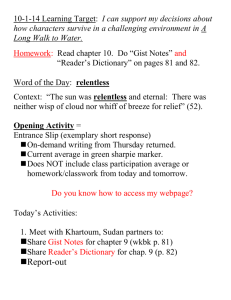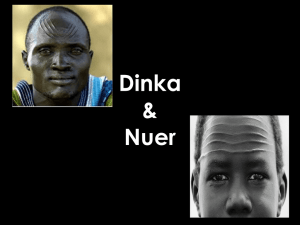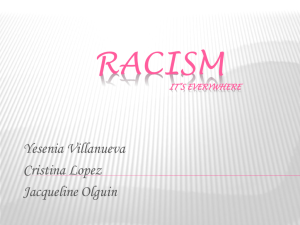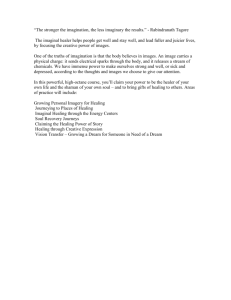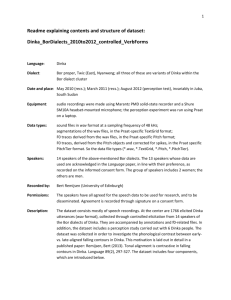Document 10464740
advertisement
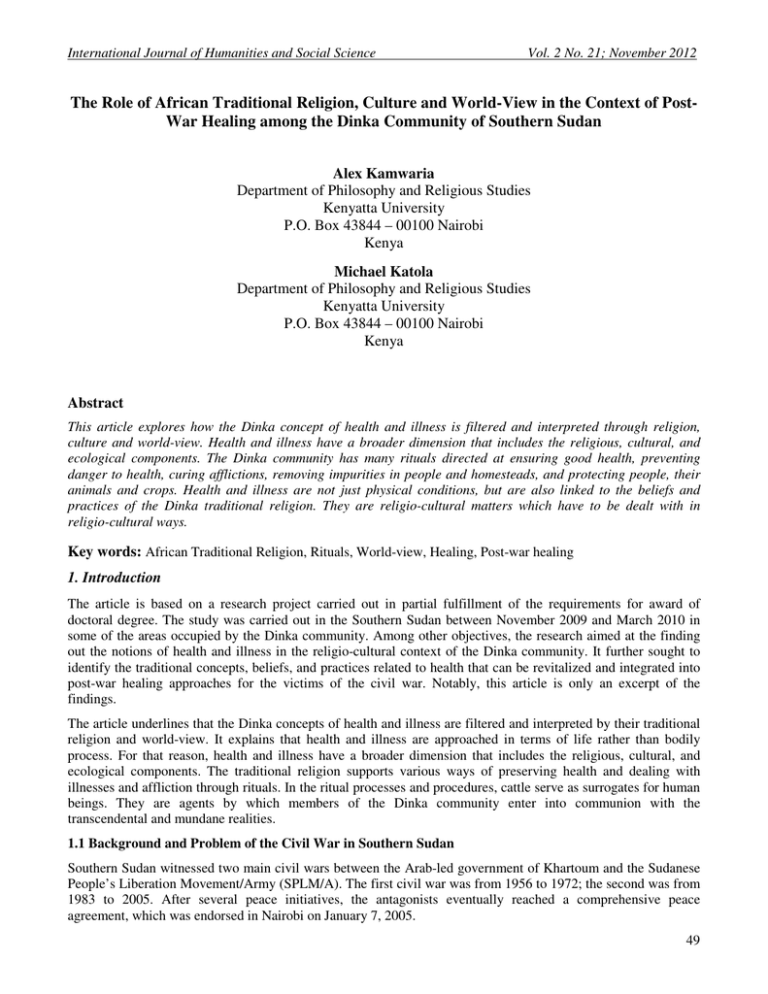
International Journal of Humanities and Social Science Vol. 2 No. 21; November 2012 The Role of African Traditional Religion, Culture and World-View in the Context of PostWar Healing among the Dinka Community of Southern Sudan Alex Kamwaria Department of Philosophy and Religious Studies Kenyatta University P.O. Box 43844 – 00100 Nairobi Kenya Michael Katola Department of Philosophy and Religious Studies Kenyatta University P.O. Box 43844 – 00100 Nairobi Kenya Abstract This article explores how the Dinka concept of health and illness is filtered and interpreted through religion, culture and world-view. Health and illness have a broader dimension that includes the religious, cultural, and ecological components. The Dinka community has many rituals directed at ensuring good health, preventing danger to health, curing afflictions, removing impurities in people and homesteads, and protecting people, their animals and crops. Health and illness are not just physical conditions, but are also linked to the beliefs and practices of the Dinka traditional religion. They are religio-cultural matters which have to be dealt with in religio-cultural ways. Key words: African Traditional Religion, Rituals, World-view, Healing, Post-war healing 1. Introduction The article is based on a research project carried out in partial fulfillment of the requirements for award of doctoral degree. The study was carried out in the Southern Sudan between November 2009 and March 2010 in some of the areas occupied by the Dinka community. Among other objectives, the research aimed at the finding out the notions of health and illness in the religio-cultural context of the Dinka community. It further sought to identify the traditional concepts, beliefs, and practices related to health that can be revitalized and integrated into post-war healing approaches for the victims of the civil war. Notably, this article is only an excerpt of the findings. The article underlines that the Dinka concepts of health and illness are filtered and interpreted by their traditional religion and world-view. It explains that health and illness are approached in terms of life rather than bodily process. For that reason, health and illness have a broader dimension that includes the religious, cultural, and ecological components. The traditional religion supports various ways of preserving health and dealing with illnesses and affliction through rituals. In the ritual processes and procedures, cattle serve as surrogates for human beings. They are agents by which members of the Dinka community enter into communion with the transcendental and mundane realities. 1.1 Background and Problem of the Civil War in Southern Sudan Southern Sudan witnessed two main civil wars between the Arab-led government of Khartoum and the Sudanese People’s Liberation Movement/Army (SPLM/A). The first civil war was from 1956 to 1972; the second was from 1983 to 2005. After several peace initiatives, the antagonists eventually reached a comprehensive peace agreement, which was endorsed in Nairobi on January 7, 2005. 49 © Centre for Promoting Ideas, USA www.ijhssnet.com This ended the Africa’s longest-running and deadliest war and further saw many refugees and asylum seekers return to their motherland. The return to motherland took a long time, given the adverse effects of war on resources and infrastructure. The scale and duration of the war has engendered massive health complications in the form of physical, social and emotional problems. In addition to losing their loved ones through death, many victims are still nursing the physical and psychic injuries. Others continue living in squalor, hunger, and dire poverty. Special attention needs to be given to the victims of civil war, so that they may resume normal and productive life. The Dinka community, which was much affected by the civil war, has to be assisted to regain its own social balance and harmony. Therefore, healing of afflictions and cleansing of evils caused by the civil war is imperative if peaceful and harmonious co-existence is to continue in the community. It is in this regard that this research was undertaken to find out the appropriate means of healing the war affected victims in the Dinka community. 1.2 Data Collection Methods Data was obtained from primary and secondary sources. Three types of research design, namely, explorative, survey and descriptive were used to enhance data collection. Explorative design was utilized in the identifying the problem and review of related literature. Survey design was used in the formulation of research instruments and determining the sample size and categories for interviews. Descriptive design was used in the interpretative qualitative methods that were used to provide a rich and textured view of the issues as they presented by respondents. Extensive field visits were undertaken, whereby semi-structured and structured interviews were conducted with the members of the Dinka community. Structured interviews were also conducted on key informants such as the indigenous ritual experts, ex-combatants, and victims of the civil war. In-depth interviews were also conducted with the key informants whose views and perceptions on the post-war healing rituals were solicited. 2. Who are the Dinka? The Dinka people designate themselves, Monyjien or Jien, meaning “People of the people.” Scholars like Lienhardt (1961) and Deng (1972, 1980) agree that this is the strongest term existing in their language. The term is redolent of their pride and superiority. Their stature, among the tallest people in the world, is complemented by a proud and fiercely independent spirit, expressed by their men in self-designation as “The Men of Men” or “The Husbands of People.” It has been suggested that the name Dinka is the etymological origin of well-known root Jienje, commonly used by foreigners, ostensibly the Arabs, whose pronunciation gave a distorted sound as Dinka. Alternatively, the ethnic root Deng Kok or “the People of Deng” is probably the etymology of the name Dinka. The Dinka community has more than 24 sub-groups. However, the most distinct groups are four, namely, Bor, Agar, Rek, and Ngok since they possess religious and cultural heritage common to the other sub-groups (Lienhardt, 1961). The Dinka population is estimated to be around 2 million (Deng, 2000). The actual statistics remain blurred partly because of the effects of the civil war, and their adage that “one does not count the number of his children.” The Dinka live in the Southern Sudan along both sides of the White Nile. They cover a wide area along the many streams and small rivers concentrated in the Upper Nile province in southeast Sudan and across into southwest Ethiopia. Precisely, their territory falls within twelve and six degrees North latitude, stretching in the Southern Sudanese provinces of Bahr el Ghazal, Lakes, Jonglei and Upper Nile, with the enclave of the Ngok Dinka extending into the Northern Province of Kordofan. The Dinka are basically pastoralists, but supplement pastoral pursuits with seasonal cultivation. Cattle are integral to their economic, social and religious life. Traditionally, they have a highly egalitarian and independent manner of life. The Dinka distinguish two categories of clans: priests or bany, and commoners or warriors or kic. The clans are headed by the spear-masters, who also double as leaders and ritual experts. This elite group influences the community health and well being through appeal to rituals and mystical powers. Though their influence has been weakened by changes brought about by modernity, their role on matters pertaining to beliefs, practices, health, and illness still hold. 3. The Dinka Culture and World-View The term culture is very inclusive. It takes account the religious, social, psychological, linguistic, political, economic, and many other aspects of life. Kraft (2000) defines culture as a design for living, a plan according to which society adapts itself to its physical, social, and ideational environment. 50 International Journal of Humanities and Social Science Vol. 2 No. 21; November 2012 Physical adaptation includes such matters as food production, skills, and technology. Social adaptation includes political systems, kinship, lineage, family organization (nuclear or extended), and all things which enable one to interact with others. Ideational adaptation entails knowledge, art, magic, science, philosophy, and religion. Geertz (1978) defines culture as a historically transmitted pattern of meanings embodied in symbols by means of which men and women communicate, perpetuate and develop their knowledge and attitude to life. Helman (1994: 2-3) defines culture as set of guidelines (both explicit and implicit) which individuals inherit as members of a particular society, and which tells them how to view the world, how to experience it emotionally, and how to behave in relation to other people, to supernatural forces or gods, and to the natural environment. World-view as the way people see or perceive the world; the way they know it to be (Kraft, 2000: 21). What people see is in part what is there; it is partly who they are. World-view is humanity’s idea of the universe; the organization of ideas that answers questions such as, Who am I? Among what do I move? What are my relations to other people, things, or events? (Chima, 1999: 35). World-view is taught to people from birth, and it is so persuasive that most of people think that their view of reality is the only accurate one. From the above definitions, it can be concluded that culture is closely related to world-view. Culture is so embedded in one's mind that its structures, values, and ideals are experiences which are seen as normal. Culture thus communicates people’s world-view in that it operates likes a communication system, an operating system in a computer, or a neural network within the neo-cortex of one's brain (Kirwen (2005: ii). Culture shapes the worldview in that it interprets experiences, determines and animates over 90% of an individual’s daily activities (Kraft, 2000). 4. Dinka Traditional Religion The Dinka have no term corresponding to religion. The concept of religion sometimes refers not only to God but also to ancestors and forces of nature. It is possible to pray to ancestral spirits but not as distinct as God, whom the Dinka call Nhialac. Often the highest manifestation of spirit, God, is prayed to directly. Nhialac is the creator and source of life but is too distant for direct contact with humans. Due to this, sacrifices are made through appeal to the ancestral spirits called Yath and Jak. The Dinka have special regard for the ancestors. Belief in the ancestors is largely based on the notion that life continues after death and that communion and communication are possible between the living and the living dead. Fundamentally, ancestors are the spirits of the deceased relatives, and for many individuals are the primary intermediaries. Ancestors are believed to take interest in the day to day affairs of the community and have powers to influence the affairs of the living either for good or for worse. They play the role of guardians of public and private morality, and unseen presiders at family meetings. They also act as intermediaries between the living and divine beings. They are believed to be involved in the practice of medicine and can, upon request, send special cures to their relatives who are seriously sick. The ancestors, by virtue of being part of the extended family and living in proximity of God the creator, are endowed with special powers. The ancestors continue to be part of the family and are included in all the events of the family, clan or community. Although ancestors are invisible, they reside in the community like everyone else. They have favourite dwelling places, like shrines, cattle byres, houses, etc. In the Dinka’s belief, offerings to the dead express an attitude that passage into the invisible world has not destroyed life in the community. The Dinka people belief that ancestors lead somewhat similar lives as they did whilst alive, and are considered to retain the same temperaments and status they had as people. Ancestors have exceptional powers, and can make their presence known through fortunes, misfortunes, or materialize in different forms, such as birds, certain types of snake, etc. They may be driven to wrath if living members do not propitiate them in life crisis rituals such as in birth, naming, initiation to adulthood, marriage, death and funeral. They also expect to be propitiated in peace, harmony and healing rituals. The Dinka attribute any remarkable occurrence to the direct influence of spirits and will sometimes mark the occasion with an appropriate ritual. For example, experiences of civil war make people exposed to evil, and therefore ill. Those who participated in the war as combatants picked up malevolent spirits of the dead, which not only afflicted them, but also the entire community. Even those who did not participate as combatants, but witnessed the atrocities of the war are afflicted because they either came into contact the dead or walked near the dead people. 51 © Centre for Promoting Ideas, USA www.ijhssnet.com 5. Dinka Notion of Health and Illness Like in many African communities, the Dinka people define healing in terms of peace since the term imports the idea of completeness, harmony, and hope (Johnson, 2003: 168; Amisi, 2008: 14). When an individual is healed, s/he is ‘at peace’. Healing also encompasses the idea of ‘wholeness’, which the Dinka value as a state of balanced and harmonious relationship between people, God, ancestors, and nature. Health is a state of complete well-being based on a way of living, conduct and behaviour in relation to the others. It gives due respect to the dignity of the person and brings about a link of the person with God, ancestors, community, and environment. Illness was perceived as a health disorder resulting from complex interaction of physical, spiritual, sociological, and physiological factors. In other words, illness was seen as psychosocial and psychosomatic. Restoration of health or healing was approached in terms of an interactive life process rather than just in terms of a bodily process. In this sense, healing acquired a broader dimension that included restoration of broken relationships between people and God, spirits, and environment. Healing was a holistic and transformative process of restoring troubled peace between people, God, spirits, and nature. It was a religious matter that had to be dealt with in a religious manner. The study noted that the Dinka health care system involves the whole community. Since healing is an interactive process, when one member of a community suffers from illness, everyone in the community suffers. Therefore, everyone in the community is in some sense concerned with and affected by the need to address the malady of the diseased member. Accordingly, when widespread calamity hits the community, such as war, it is attributed to the disrupted or broken relationships which should be restored before the community could regain its social harmony and stability (Field research interviews, December, 2009). Since illness is caused by a broken relationship, the community becomes the starting point for diagnosis and treatment. The indigenous healing rituals provide ample opportunity for the kith and kin in the community to participate in the diagnosis, prognosis, and treatment. In contrast, the Western health care system physically isolates the patient from his/her family, companions, neighbours, community, and natural surroundings. Usually, the patient is confined in a strange world known as the hospital. Contact with family and community are regulated. In addition, the participation of the family and community to healing of the patient is limited to the payment of medical bills. The study further noted that in the Dinka traditional concept, an individual is viewed both in his/her collective identity as a member of the community, and in his/her personal identity as a unique individual. As far as the notion of health is concerned, the individual is truly human in so far as he/she is an integral member of the community. Mbiti (2002: 108-9) summarizes this point by noting: Only in terms of other people does individual become conscious of his own being…When he suffers, he does not suffer alone but with the corporate group…Whatever happens to the individual happens to the whole group, and whatever happens to whole group happens to the individual. The individual can only say: ‘I am because we are, and since we are, therefore I am’. This is in contrast to the Western concept that is founded on Descartes’ dictum, Cogito ergo sum, - I think, therefore I am. In the Dinka traditional concept, it is not the individual’s capacity to think that leads to wholeness and guarantees integral and holistic health. Rather, the fact that one belongs, participates and shares life with others ensures one’s wholeness and well-being. Therefore, individualism is an abomination, and corporate living is encouraged. 6. The Dinka Notion of Evil Among the Dinka, the notion of evil is expressed in terms of social pollution or Nueer. The agents of evil can be the angered spirits of those killed during the civil war, or those not properly buried. Interviews with some Dinka elders indicated that being haunted means that an individual has picked up some angry spirits who can cause afflictions not only to the individual killer, but also entire members of the family and community. The elders further revealed that individuals who participated in war as combatants must have either killed or come into contact with blood. Such people, the elders said, are polluted by war experiences. They are vehicles through which spirits of the dead might enter and afflict the community. Therefore, when fighters return home after the civil war, they are held to be potentially harmful to health of the community. This was well captured in the following statement by an informant: 52 International Journal of Humanities and Social Science Vol. 2 No. 21; November 2012 If one engages in war as a fighter, he learns how to kill others, and thus becomes afflicted by the evil. The spirits of those he killed haunt him, his family members and even the entire community…he is not normal (ill) because during the war, many other things also happened to him such as seeing or coming into contact with the blood of others, carrying or touching dead bodies besides killing others… When such a person comes back to the village, he can hardly fit into the normal life… those angry spirits will haunt him throughout his life… He has to be treated to become his own self again (Field research interview, December, 2009). Rituals of exculpation must be conducted to restore the broken relationship by appeasing the spirits of the deceased, and settle them in proper status in the ancestral world. This is a crucial means of preventing any anger and aggression by the spirits of the deceased. The rituals restore the health of the individual and the community by expunging the evils caused by the immoral acts of civil war. The rituals exhibit a very strong bond between the mundane (physical world) and transcendent (spiritual world). The spirits of dead are believed to interfere or intervene in the life of living. If well propitiated, they protect and guide people, ensure harmony in the community, promote fertility of land and people, and give good agricultural yield. If not well appeased, they withdraw their protection and create a state of vulnerability to misfortunes, afflictions, and even cause death. 7. Dinka Post-War Healing Rituals The precise origin of indigenous healing rituals is speculative, though some scholars argue that responses to afflictions emerged in proto-cultural humans and were retained through natural selection in human evolution, leading to a health-seeking behaviour (cf. Katz, 1982; Gumede, 1990). Others trace their roots back to the fishing and hunter-gatherer communities, whose occupation produced emotional stress due to the dangers and uncertainties faced. Rituals were social events where a community united to deal with situations of stress that threatened its harmony and stability (Malinowski, 1954; Rudnick, 2003: 191). All in all, the origin indigenous healing system is still a matter of conjecture. As stated above, religion, culture and world-view are essential components in the Dinka health care and healing systems. The Supreme Being (Nhialac) constitutes a remote, yet near divinity. People relate directly or indirectly to Nhialac. Any immoral behaviour is considered a direct affront against Nhialac, the ultimate guardian of morality. The expectation is that Nhialac would punish the transgressor, or someone closely related to the transgressor, through manifestations of illness, death, or other misfortunes. Killing is governed by an even stricter set of norms, which require among other things, the killer be ritually purified of the embittered spirit of the killed victim. Failure to do so leaves the killer vulnerable to a highly contagious form of social pollution, or Nueer. Thus, ancestral veneration and worship of Nhialac constitute part of everyday rituals. Performance of healing rituals gives individuals or groups a sense of security, familiarity and stability, which they need to carry on with their lives. The centre of these rituals is sacrifice, in which case cattle are the main sacrificial victims. Our interviews with some Dinka victims of civil war revealed that in the event of illness and afflictions, they often move across the borders of biomedicine (hospitals) to indigenous healing rituals. It was noted that more often than not, the patients start with the hospitals, and then move on to indigenous healers (herbalists, diviners, spirit mediums, seers) to complete their treatment. In some case, there is a combination of all the healing approaches. In the context of post-war healing, the Dinka perform healing rituals, known as Cieng (Deng, 2000). Etymologically, the term Cieng connotes ‘to put in order’, and encapsulates the ideology of transformation, corporate responsibility and social cohesion (Deng, 1980). Traditionally, the Dinka community understood war as cause of disharmony between people, God, spirits, and nature. Most Dinka people believe that those who participated in the civil war as combatants killed and committed terrible atrocities, and therefore suffer from Nueer. As such, they need appropriate Cieng rituals in order to reintegrate to normal life in the community. Such rituals provide treatments that are believed to prevent haunting or retaliation by the angry spirits of the deceased. Cieng rituals for the victims of civil war fundamentally consist of purification and cleansing. In these rituals, there are some specific treatment procedures according to the nature of involvement in the civil war. Our informants revealed that those involved as fighters were initiated and mobilized through traditional rituals. Part of this initiation and mobilization was done in the bush and entailed imparting skills to improve fighting with mystical help. The spirit mediums would tell the combatants which way to go, when and from which direction the enemies would come. Traditional medicine-men also gave mystical protection from bullets and potency for mystically transforming into an animal and disappearing from the sight of an enemy. 53 © Centre for Promoting Ideas, USA www.ijhssnet.com After the war, these combatants were disarmed and demobilized by the so-called international peacekeepers but could not fit to village life. This is because they were still bound by initiation rituals as combatants (Field research interviews, December, 2009). Ritual for demobilization and reintegration of such ex-combatants involved sacrificing a bull. Our field interviews revealed that the common practice was that when such a ritual is to be performed, the head of the household proceeds to the cattle byre and spends some time loudly cajoling the ancestral spirits. He then selects a bull and presents it the ancestors. More often than not, the type of a bull that is selected is one that is very aggressive, and therefore likely to make a lot of bellowing while dying. The bellowing connotes the approval by ancestors. The colour of the bull is pure white or brown, popularly known as Mabior. Purity of the colour symbolizes the purity of sacrifice. There is a highly developed symbolic relationship between Dinka and their cattle. The Dinka lifestyle centers on cattle in terms of their roles within the community, their belief systems, and ritual practices. Scholars like Lienhardt (1961), Deng (1972), Nebel (1979) and Nikkel, (2001) note that the levels and forms of relationship among the Dinka are couched in bovine idioms. The Dinka’s ties to cattle also spills over into their terminology and naming systems. For example, the term Wut can connote either a ‘group of men’ or a ‘group of cattle’. Both Dinka and their cattle undergo through somewhat similar stages of development with regard to social categories. For example, just as the Dinka categories falls into children, women, adult men, influential adults (usually elders), so too, cattle fall into categories of calves, cows, oxen and bulls. Cattle are given personal names, and on many levels people in fact imitate cattle in terms of their actions and mannerisms. Men take pride in the aggression of their bulls, which corresponds to their bravery and heroism. During the battles, warriors boast and maintain the strength, fierceness and tenacity of their bulls. When they exert themselves physically in the community, the Dinka men show off that they have the power and might of a bull. When in company of other men, they display their masculinity by boasting that they have the aggressiveness of a bull. When they procreate, they boast that they have the ‘sexual potency’ of a bull. Although elderly men adore bulls, they are not as obsessive as the adult men and warriors (Lienhardt, 1961: 10f.). Since people imitate cattle and become their cattle in terms of their behaviour, they are prohibited by social mores from eating the meat of cattle of their name. In the family circles, they compensate for its death by naming the next child after it. Lienhardt (1961: 19) notes that while prohibition and compensation “may not always be taken seriously,” they do point to the intimacy between Dinka people and their cattle. It was noted that the notions behind the parallels and uses of cattle in rituals and ceremonies provide insights why cattle are central in the healing rituals. Interviews with some ritual leaders revealed that cattle are the usually the first choice as sacrificial victims. They serve as expiatory substitutes for human beings and are agents by which transcendent and mundane are connected. Cattle are the means by which the Dinka people enter into communication with God and other spiritual entities. The ritual leaders underlined that since cattle are as valuable as Dinka people, sacrificing them to God is as serious and resolute act as sacrificing individuals. Therefore, cattle sacrifices are the perpetual connection between the Dinka people and God. In the healing of post-war afflictions, the animal that bears the name of the sick person is sacrificed. The sick person, on whose behalf it is being sacrificed, rubs his body against the animal. He proclaims to the animal the important and necessary purpose for which it is being victimized. Thereafter, the animal’s throat is slit and the sick person jumps over it while it is still shaking and groaning to death (Field research interviews, December, 2009). The rubbing against it, announcing the purpose of its death, and jumping over it are symbolic acts of transferring all evils, afflictions, or Nueer to the sacrificial victim. The death of the animal symbolizes expiation and locking away of the past. The pouring of blood is meant to appease the angered spirits of the deceased so that they would not return to haunt the sick person or his kinsmen. Once dead, the animal is skinned, and some parts are separated so that the ancestors are given their part (through burning meat to ashes), while the participants eat the rest. Some part of the blood is poured as libation to ancestors, while the rest is sprinkled to ritual participants. Family members and the community attend these rituals. It is during these rituals that the sick person is purged and cleansed of the contamination and guilt arising from the war experiences. Before the ritual is performed, interaction with family and friends is prohibited. The person undergoing the ritual is kept out of the homestead. This symbolizes that the person is in a liminal status, betwixt and between, and therefore in need of reintegration into the family and community. Generally, Cieng rituals bring together a series of symbolic enactments aimed at sealing the past and forging peaceful and harmonious co-existence. 54 International Journal of Humanities and Social Science Vol. 2 No. 21; November 2012 The Dinka post-war healing rituals present a holistic approach to health by combining both the social and physical dimensions of illness in order to treat the person as a whole (Field Research Interviews, February, 2010). Here there is an overall integration of body and mind, and the Cartesian dichotomy does not apply. The social imbalance in a patient’s life is generally reflected in the physical body, and both dimensions are equally taken into consideration to restore the patient’s health. The corollary is that healing is achieved through a double strategy: spiritual healing which deals with the supernatural causes of illness through rituals; and physical healing which addresses relieve of body pains through the use of herbal remedies. Moreover, the individual is not seen as a singular entity, but rather as part of a community. During the healing session the healer carries out a careful examination of the state of the patient’s social relationships in the community (relationships with the living, spiritual world, and nature) to achieve a diagnosis (Field research observation, February, 2010). The healer-patient dialogue that develops during the consultation represents a reciprocal learning process in which transference and counter-transference of experience occurs and brings them together. In this context, the relationship between healer and patient becomes very close and enhances the spiritual and cultural bonds between them. In this regard, indigenous healing becomes very effective in dealing with post-war afflictions. 8. Conclusion The article has highlighted that the Dinka culture, religion and world-view include the social and religious components. It has explained what the Dinka notion of health, illness and evil constitute. Post-war healing rituals are religious and cattle are key sacrificial victims. The Dinka ties to cattle are expressed in their vocabulary and idioms of social relationships. Cattle serve as the agents by which members of the community enter into communion with the transcendental and mundane realities. The article has noted that among the Dinka, health and illness are approached in terms of social relationships rather than bodily processes. In this sense, health acquires a broader dimension to include the physical, spiritual, sociological, and physiological factors. Equally underlined is the notion of Nueer, which constitutes an important factor in the context of post-war healing. After the civil war, people become exposed to evils when they get into contact with death and bloodshed, especially those whom they killed. Such people are seen as the vehicles through which the angry spirits of those killed might enter and afflict the entire community. Many Dinka people integrate both the indigenous and modern approaches to health and healing into their lives and manage to comfortably harmonize these seemingly incongruent approaches. The presence of hospitals and clinics that provide health services to many Dinka people attest to the fact that on many levels biomedicine continues to be utilized. Yet the acceptance of biomedicine is only partial, and that many patients routinely consult indigenous healers after their hospitalization to complete their treatment, and perhaps to determine “who” caused the illness or “why” the illness came. 9. References Amisi, B.K. (2008). Indigenous Ideas of the Social and Conceptualizing Peace in Africa. Africa Peace and Conflict Journal, 1(1), 1-18. Chima, A.B. (1999). Communication, culture and community. Nairobi: Paulines. Deng, F. M. (1972). The Dinka of the Sudan: Case Studies in Cultural Anthropology. New York: Holt, Rinehart & Winston. Deng, F. M. (1980). The Dinka Cosmology. London: Ithaca Press. Deng, F. M. (2000). Reaching Out: A Dinka Principle of Conflict Management. In W. Zartman (Ed.), Traditional Cures From Modern Conflicts (pp. 95-126). London: Lynee Reinner. Geertz, C. (1977). The Interpretation of Cultures. New York: Basic Books. Gumede, M. V. (1990). Traditional Healers: A Medical Doctor’s Perspective. Johannesburg: Skotaville Publishers. Helman, C. (1994). Culture, Health and Illness (3rd ed.). Oxford: Butterworth-Heinemann. Johnson, D. H. (2003) The Root Causes of Sudan’s Civil Wars. Oxford: James Currey. Katz, R. (1982). Boiling Energy: Community Healing Among the Kalahari Kung. England: Harvard Univeristy Press. Kirwen, M. C. (2005). African Cultural Knowledge: Embedded Themes and Domains. New York: Maryknoll. Kraft, C.H. (2000). Anthropology for Christian witness. NY: Maryknoll. Lienhardt, G. (1961). Divinity and Experience: The Religion of the Dinka. Oxford: Oxford University Press. Malinowski, B. K. (1954) Magic, Science and Religion. New York: Anchor Books. Nebel, A. (1979). Dinka-English Dictionary. Oxford: Clarendon Press. Nikkel, M. R. (2001). Dinka Christianity. Nairobi: Paulines. Rudnick, H. (2003). The Links Between Western Psychotherapy and Traditional Healing. Doctor Litterarum et Philosophiae in Psychology. Rand Afrikaans University. Pretoria. 55
